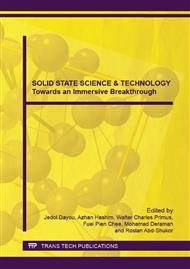p.595
p.601
p.606
p.611
p.616
p.625
p.631
p.637
p.643
The Influence of Sintering Time in High and Low Density Bi-2223 Superconductor
Abstract:
The effects of sintering time in high and low density Bi-2223 phase formation have been investigated. The samples were prepared by the solid-state reaction method at various sintering times ranging from 24, 48, 72 and 96 hours. Sucrose was added during palletization and after heated at 400°C for two hours the sucrose was removed and hence low density sample was created. The samples were characterized by X-ray diffraction (XRD), scanning electron microscopy (SEM) and critical current density. The transition temperature varies between 102 K and 96 K with increasing of sintering times. The optimal sintering time of the samples Bi-2223 system was found at 850°C for 72 hours. The critical current density, JC of high density and low density Bi-2223 was measured to be 7.547 A/cm2 and 8.333 A/cm2 respectively at 77 K under zero magnetic field. The critical current density, JC and superconductivity transition temperature, TC of low density were found to be higher than the pure samples. The critical transition temperature increased with a short gap between TC onset and TC zero. The most intense peak in the XRD pattern of sample at sintering time 72 hours belong to the high-TC phase which also indicates an increase in the volume fraction of the high-TC phase with optimum sintering time.
Info:
Periodical:
Pages:
616-621
Citation:
Online since:
June 2015
Authors:
Price:
Сopyright:
© 2015 Trans Tech Publications Ltd. All Rights Reserved
Share:
Citation:


